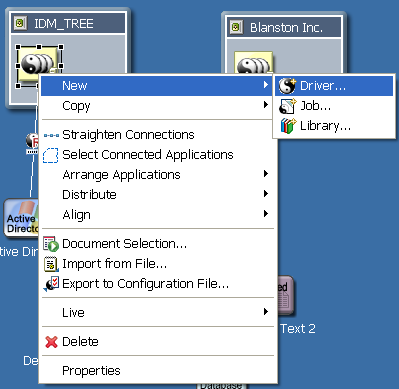|
Driver name |
The actual name you want to use for the driver. |
|
Active Users Container |
The name of the Organizational Unit object where Active users from PeopleSoft are placed. You can modify this parameter through a global configuration variable (GCV) after installation. |
|
Inactive Users Container |
The name of the Organizational Unit where Inactive users from PeopleSoft are placed. You can modify this parameter through a GCV after installation. |
|
Active Employees Group |
The name of the Group Object to which Active Employee users from PeopleSoft are added. You can modify this parameter through a GCV after installation. |
|
Active Managers Group |
The name of the Group Object to which Active Manager users from PeopleSoft are added. You can modify this parameter through a GCV after installation. |
|
PeopleSoft Connection String |
The hostname or IP address and port number for connecting to the appropriate PeopleSoft Application server. This is typically referred to as the PeopleSoft application server connection string. The default port is 9000.
The connection string uses the following format: <hostname or IP address>:<Jolt Port Number> Example: //PSServer:9000
To enable failover and loadbalancing, you can supply multiple server connection strings separated by a comma. Example: //PSServer:9000,//111.222.3.4:9000 |
|
PeopleSoft User ID |
The PeopleSoft User ID the driver uses for authentication to PeopleSoft. |
|
PeopleSoft User Password |
The PeopleSoft User password the driver uses for authentication to PeopleSoft. Re-enter the password. |
|
Password Failure Notification User |
Password synchronization policies are configured to send e-mail notifications to the associated user when password updates fail. This option allows you to send a copy of the notification e-mail to another user, such as a security administrator. If you want to send a copy, specify the DN of that user. Otherwise, leave the field blank. |
|
Allow ‘add’ events |
Subscriber Add events are implemented by invoking the Component Interface 'Create' method (if present). If you want the driver to allow Subscriber channel add events, select
.
|
|
Allow ‘delete’ events |
Subscriber Delete events are implemented by invoking the Component Interface Delete method (if present). If you want the driver to allow Subscriber channel delete events, select
.
|
|
Driver is Local/Remote |
Configure the driver for use with the Remote Loader service by selecting the
option, or select
to configure the driver for local use. (If you are using PeopleTools 8.4
x, you must select a Remote installation. Local implementations are not supported.) If
is selected, you can skip the remaining parameters.
|
|
Remote Host Name and Port |
Specify the hostname or IP address and port number for where the Remote Loader service has been installed and is running for this driver. The default port is 8090. |
|
Driver Password |
The driver object password is used by the Remote Loader to authenticate itself to the Metadirectory server. It must be the same password that is specified as the driver object password on the Identity Manager Remote Loader. |
|
Remote Password |
The Remote Loader password is used to control access to the Remote Loader instance. It must be the same password that is specified as the Remote Loader password on the Identity Manager Remote Loader. |
